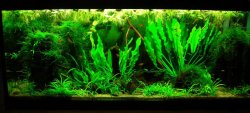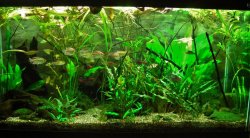catfish101
Fish Crazy
Hi all,
I've been essentially out of the planted hobby for several years, and am looking to get back into it. I'm very interested in doing this right, and my goal is transform my 60 gallon into a very low-end high tech planted tank, and I would greatly appreciate any and all input!
Current:
What I currently have is a 60 gallon tank with Seachem Flourite substrate (~2 inches deep) with a Fluval AC70 filter, and some aeration stones. Stock comprised of the following:
3 turquoise rainbows
7 cherry barbs
4 clown loaches
3 SAE
2 pictus cats
1 large rapheal cat
1 clown pleco
-This has been my stock for years, and I'm probably not going to change it much besides maybe a few additions.
Lighting:
Currently running a standard T8 bulb, but have a duel compact T5 fixture that I just need to buy bulbs for was thinking about two of these http /www.drsfostersmith.com/product/prod_display.cfm?c=3578+3733+13821+23649&pcatid=23649 but Need recommendations and input!
/www.drsfostersmith.com/product/prod_display.cfm?c=3578+3733+13821+23649&pcatid=23649 but Need recommendations and input!
CO2:
Probably just going to set up a DIY system with a diffuser that sits below a power head. This is the best way I can think of to ensure maximal diffusion, any ideas??
Ferts/Nutrients:
Also not really sure here, I know that Seachem has some good products, but could anyone recommend what I would need for this set up?
The plants I would like to keep include vals, crypts, swords, ludwiga, hygrophila, and sure a few others, recommendations???These are mostly lower tech but I am interested in investing in some higher tech attributes in order to 1. ensure healthy growth and development, and 2. prevent algae!!!
I currently have a large amount of java fern that I just introduced to the tank on a log, as well as two new sword plants. They seem to be adapting well, but this is with low light, no CO2, and no ferts. Looking to start upgrading very soon once I get some feedback here.
I've attached a few pictures so far, most of the fish are hiding but this gives a basic idea of the aquarium as it stands.
Thanks in advance for your input and I'm really looking forward to this project!!!
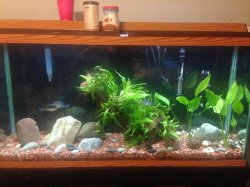
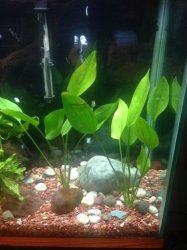
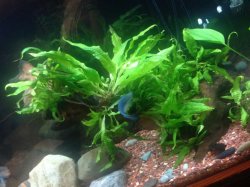
I've been essentially out of the planted hobby for several years, and am looking to get back into it. I'm very interested in doing this right, and my goal is transform my 60 gallon into a very low-end high tech planted tank, and I would greatly appreciate any and all input!
Current:
What I currently have is a 60 gallon tank with Seachem Flourite substrate (~2 inches deep) with a Fluval AC70 filter, and some aeration stones. Stock comprised of the following:
3 turquoise rainbows
7 cherry barbs
4 clown loaches
3 SAE
2 pictus cats
1 large rapheal cat
1 clown pleco
-This has been my stock for years, and I'm probably not going to change it much besides maybe a few additions.
Lighting:
Currently running a standard T8 bulb, but have a duel compact T5 fixture that I just need to buy bulbs for was thinking about two of these http
 /www.drsfostersmith.com/product/prod_display.cfm?c=3578+3733+13821+23649&pcatid=23649 but Need recommendations and input!
/www.drsfostersmith.com/product/prod_display.cfm?c=3578+3733+13821+23649&pcatid=23649 but Need recommendations and input! CO2:
Probably just going to set up a DIY system with a diffuser that sits below a power head. This is the best way I can think of to ensure maximal diffusion, any ideas??
Ferts/Nutrients:
Also not really sure here, I know that Seachem has some good products, but could anyone recommend what I would need for this set up?
The plants I would like to keep include vals, crypts, swords, ludwiga, hygrophila, and sure a few others, recommendations???These are mostly lower tech but I am interested in investing in some higher tech attributes in order to 1. ensure healthy growth and development, and 2. prevent algae!!!
I currently have a large amount of java fern that I just introduced to the tank on a log, as well as two new sword plants. They seem to be adapting well, but this is with low light, no CO2, and no ferts. Looking to start upgrading very soon once I get some feedback here.
I've attached a few pictures so far, most of the fish are hiding but this gives a basic idea of the aquarium as it stands.
Thanks in advance for your input and I'm really looking forward to this project!!!





